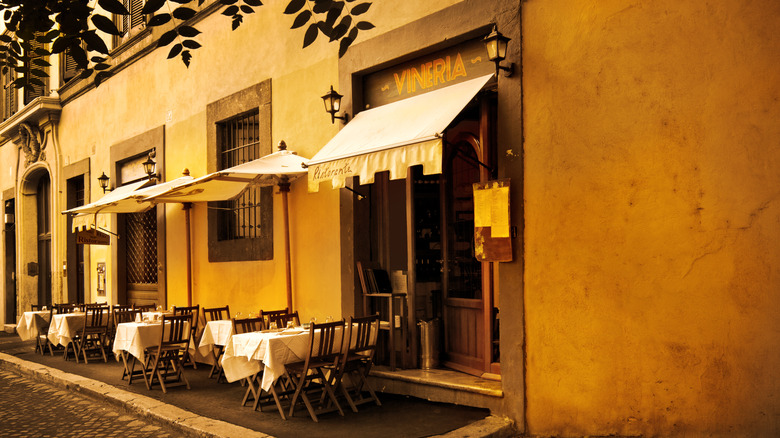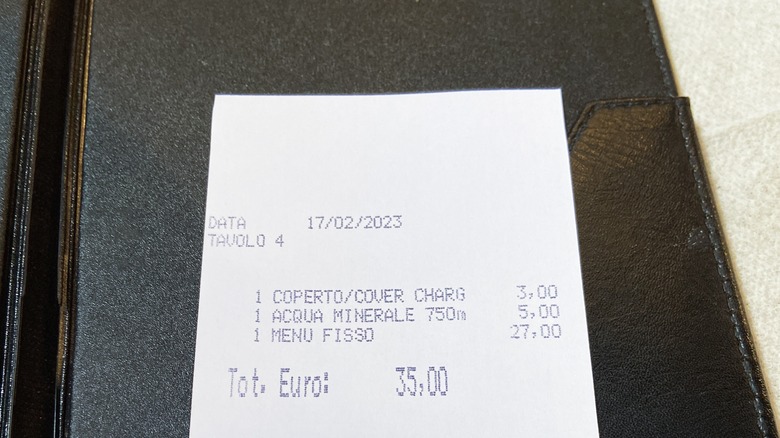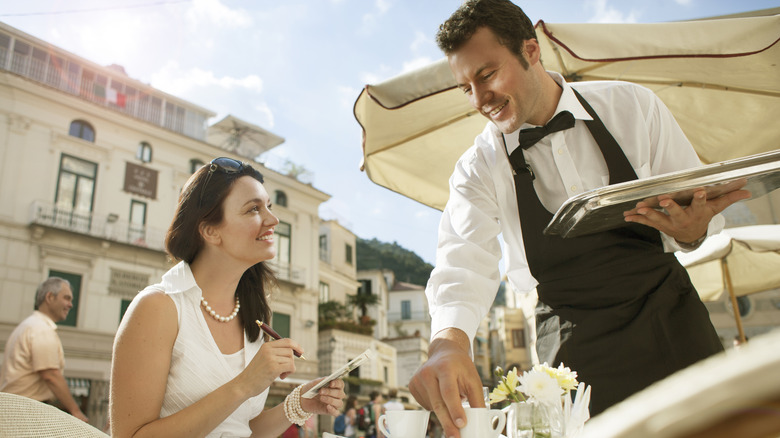Here's What It Means If Your Restaurant Bill In Italy Has A 'Coperto' Charge On It
You've just had the most remarkable dinner after your arrival in Italy. The order came out right, the food was great, and now, the bill is here. Everything checks off, except for one surprise charge that reads "coperto." Confused, you pay the bill as is, too jet-lagged, nervous, and not wanting to appear cheap as to ask about the extra euros on the cheque. Unfamiliar to many tourists, coperto might seem like a scam, but not paying it is something you should never do when visiting Italy.
However, understanding what it is and why it's there can enhance your dining experience and help avoid any surprises. Unlike a tip, which is a reward for good service and is left at the discretion of the customer, the coperto is a fixed fee that diners are 100% required to pay, regardless of the quality of service or the size of the meal. The coperto is charged per person, not per table, so each member of your party will have this charge added to their portion of the bill.
The amount can vary depending on the region, type of restaurant, and even the city of town you're in. In some places, the coperto may be as low as one or two euros per person, while in more tourist-heavy areas or upscale establishments, it could be as much as five euros or more. It's always a good idea to check the menu before ordering, as many restaurants list the per person coperto amount there.
The history of coperto
Coperto is not a new concept in Italy, it actually has deep historical roots that date all the way back to the Middle Ages. Back in the day, travelers would often bring their own food to eat inside inns and only buy drinks, so the innkeepers would charge each guest a coperto fee for the use of their tables, chairs, plates, and cutlery. Although times have changed and travelers stopped bringing their own food, the practice still remains.
Today, coperto covers the same things, the use of the table setting, linens, cutlery, waiter service, cleaning, and bread. Yes, that basket of bread you get as soon as you sit down — a very traditional Italian hospitality offering — is often part of the coperto charge. In a way, the coperto can be simply viewed as a small fee for the overall amenities and dining experience at the restaurant. It's important to note that it goes directly to the restaurant, not your server.
It's important to differentiate between the coperto and another common charge you might encounter on your restaurant bill in Italy: "servizio." While the coperto is a cover charge, the servizio is a service charge that some restaurants add to the bill, ranging from 10% to 20% of the total. The servizio is akin to an Italian tip and is often included in the bill for larger groups, although some restaurants apply it to all bills. Coperto is nearly always present, while the servizio is not as universal.
How to handle the coperto charge
Coperto is absolutely legal — both locals and tourists have to pay. You might wonder, what about tips and wages? Unlike the U.S. and some other countries, Italian servers earn a living wage that is independent of their tips. What's more, being a waiter in Italy is a career — not a part-time job or a short-term gig just to pay the bills. Regarding tips, they're always welcome but are customary in Italy only for top-notch service in upscale or fine-dining establishments, usually 10% to 15%.
Although the practice of charging coperto is widespread across Italy, it does vary depending on where you are. In regions like Tuscany, Lombardy, and Veneto, the coperto is common and often explicitly mentioned on the menu. In tourist-heavy cities like Rome, Florence, and Venice, the coperto is higher, especially in restaurants near major attractions. However, in areas such as Lazio (where Rome is located), there have been efforts to regulate or eliminate the coperto.
It's best to view the coperto as a standard part of the dining experience, much like taxes or automatic gratuities in other countries. If you're traveling on a budget, dine at more casual establishments or choose places where the coperto is lower. It's also important to remember that the coperto is not an indication of the quality of the restaurant. Some of the most authentic meals in Italy can be found in simple trattorias or osterias, where the coperto is modest but the food is exceptional.


